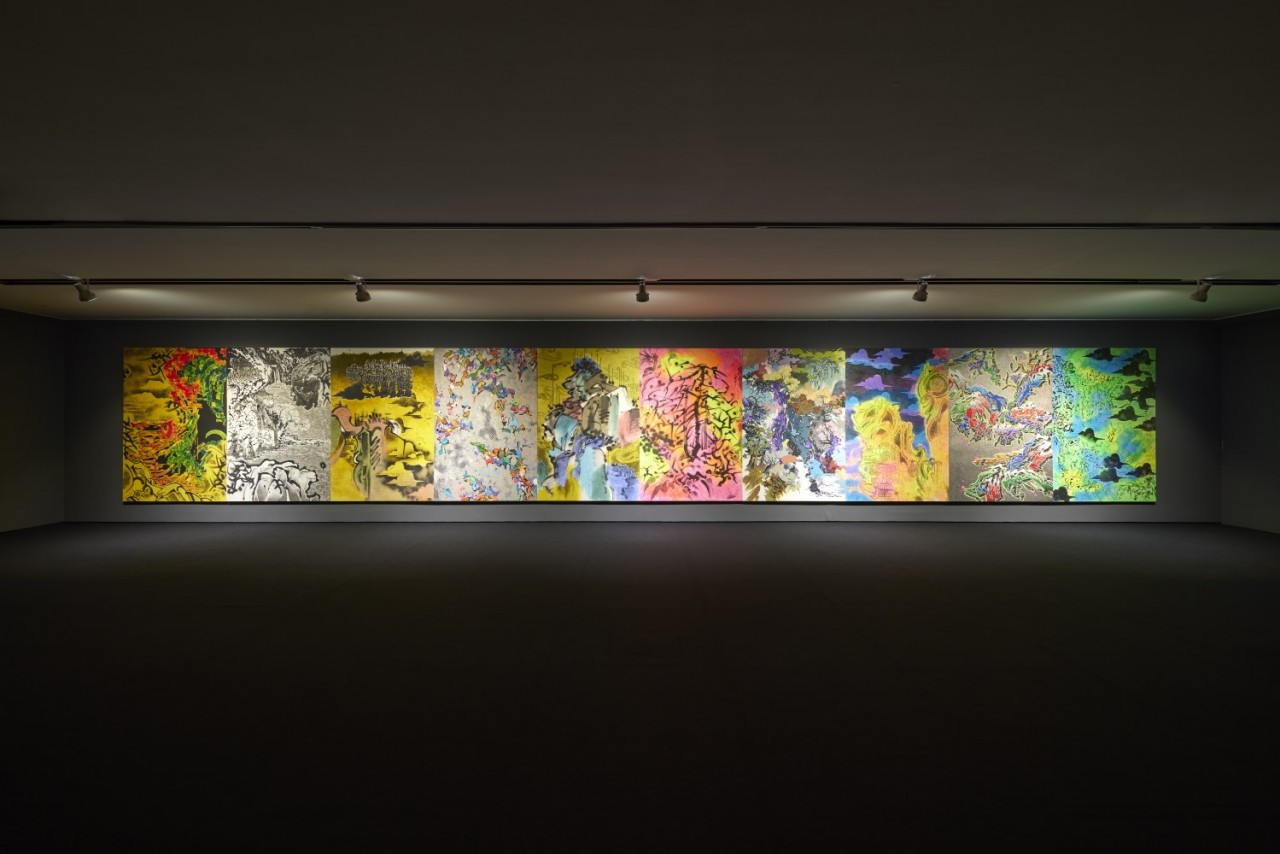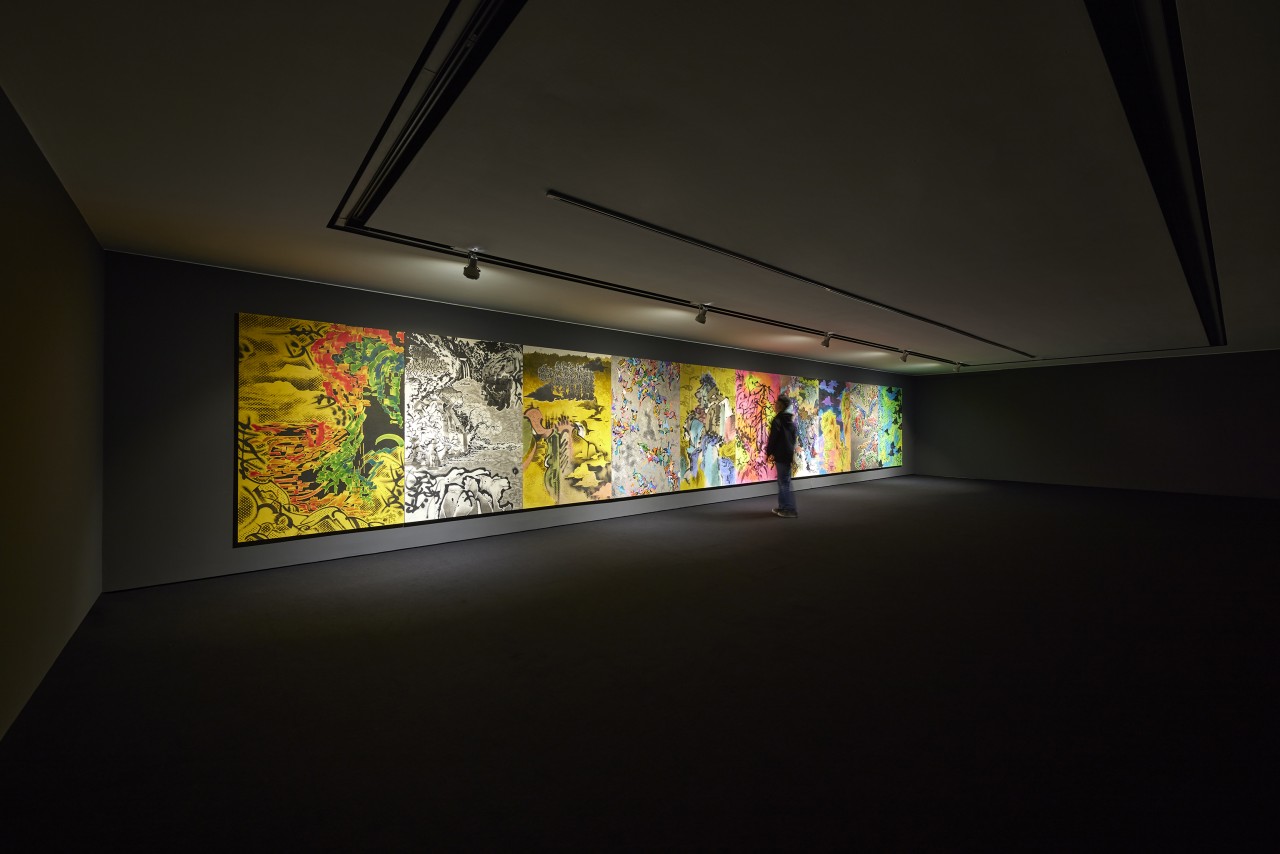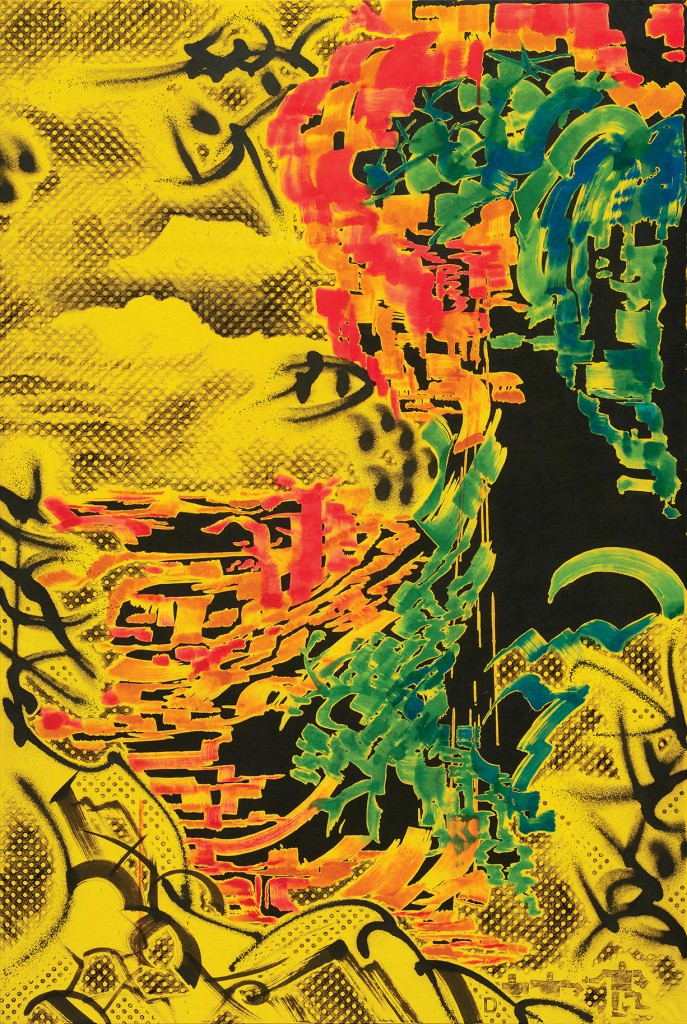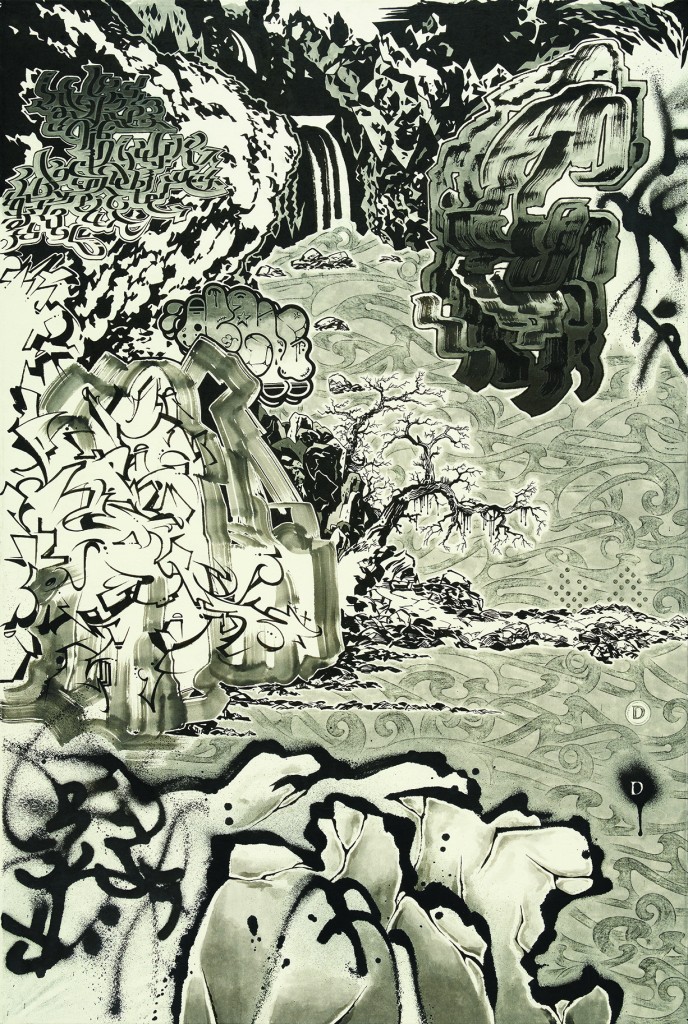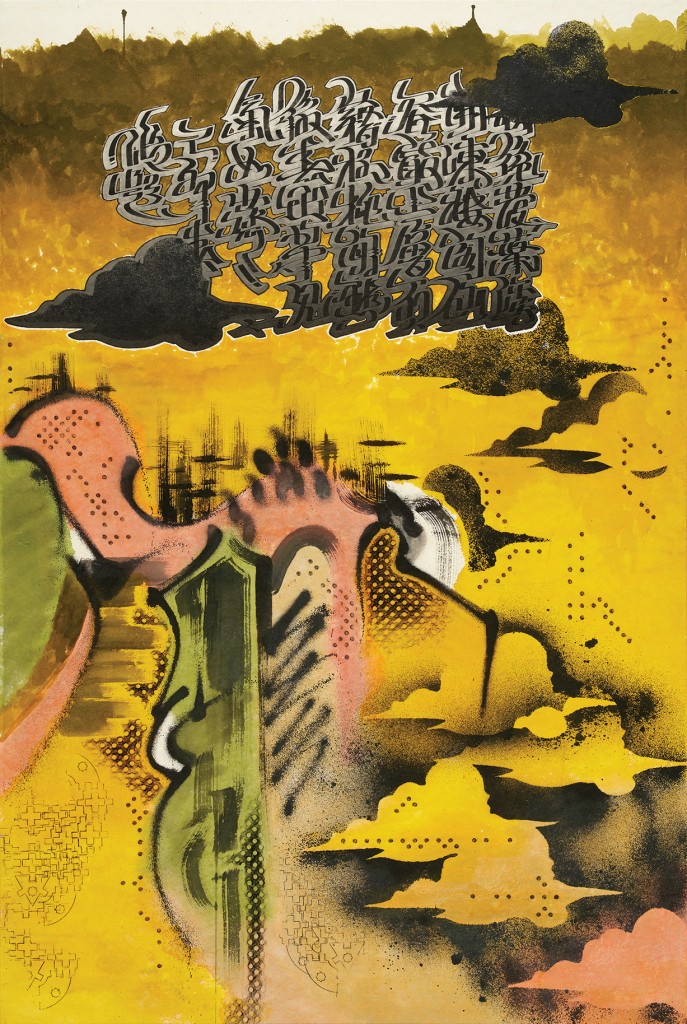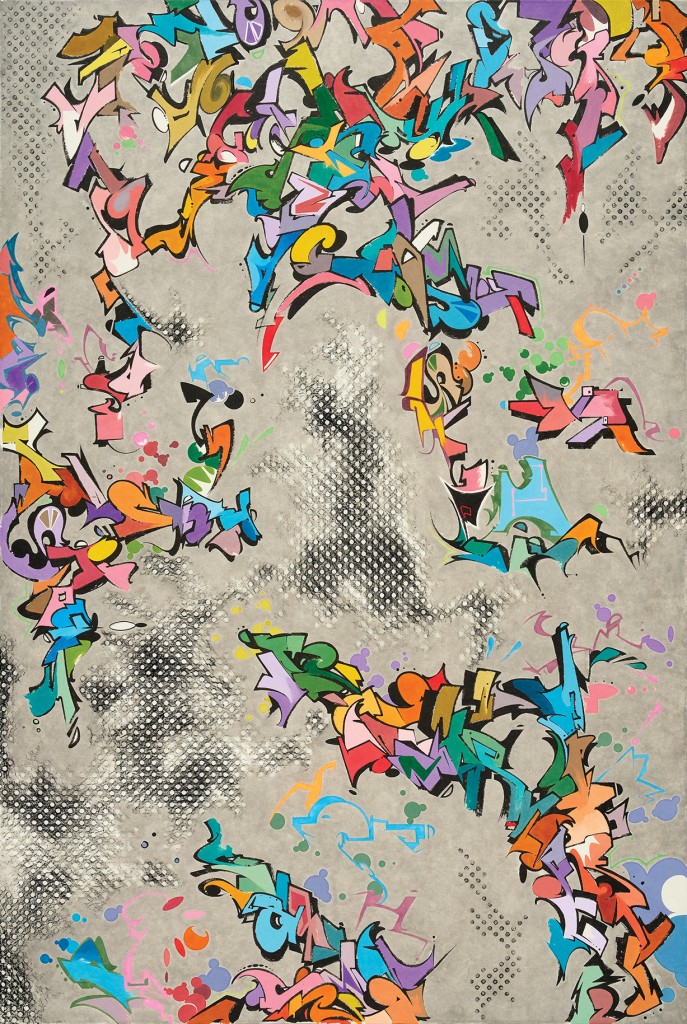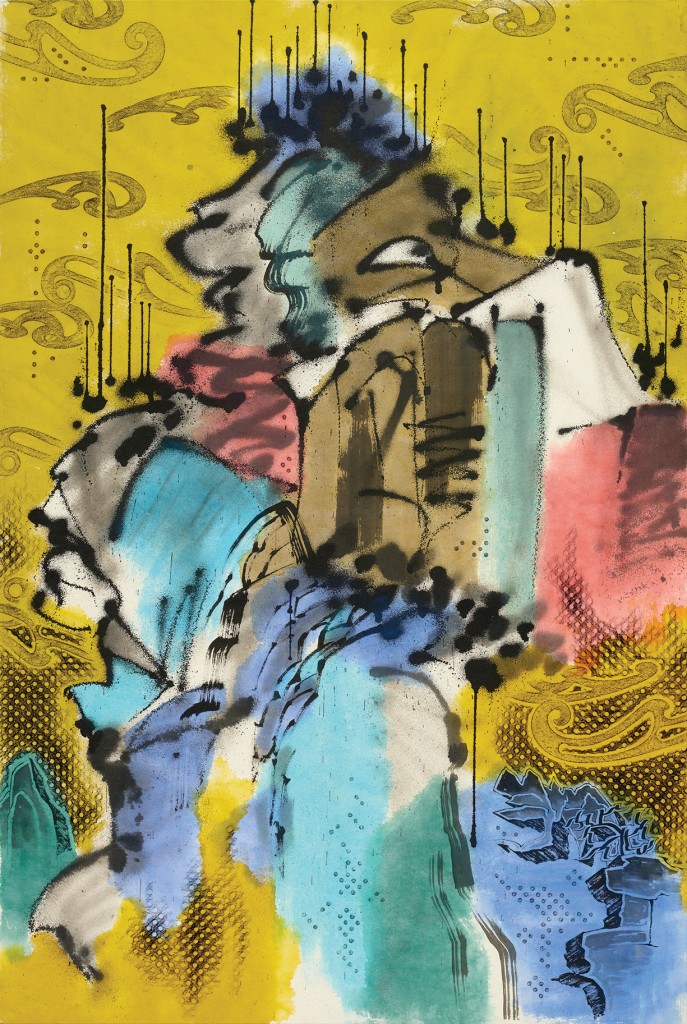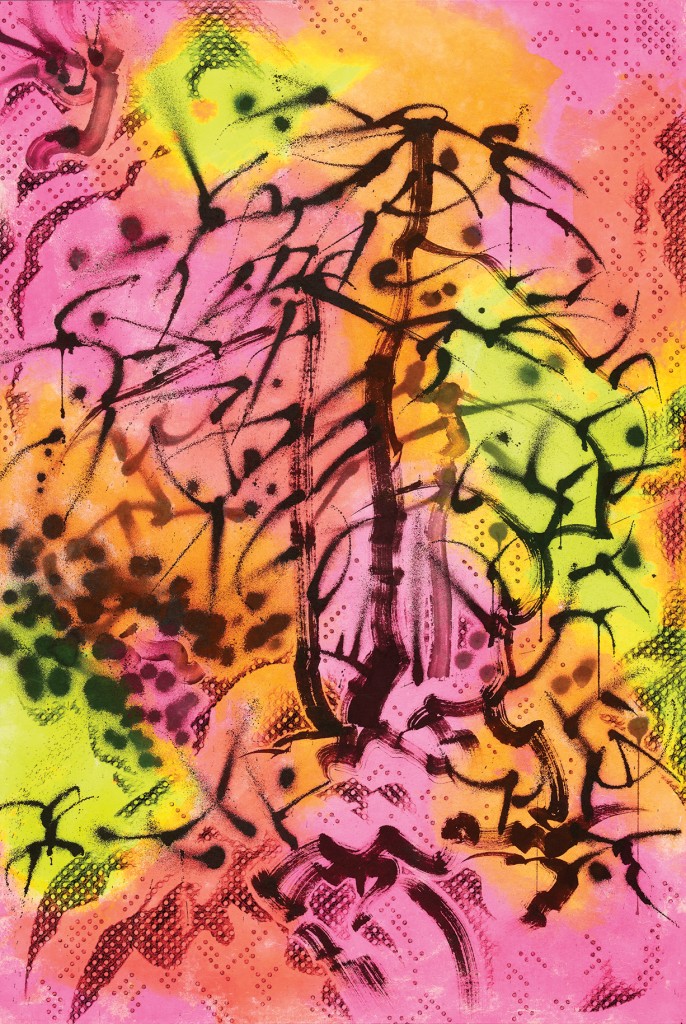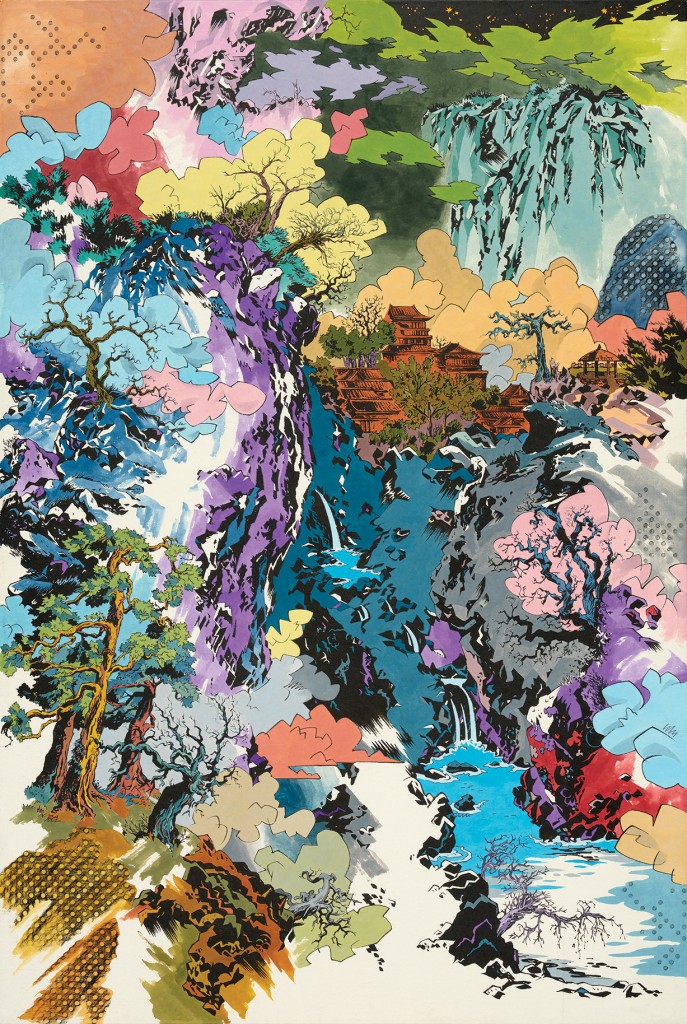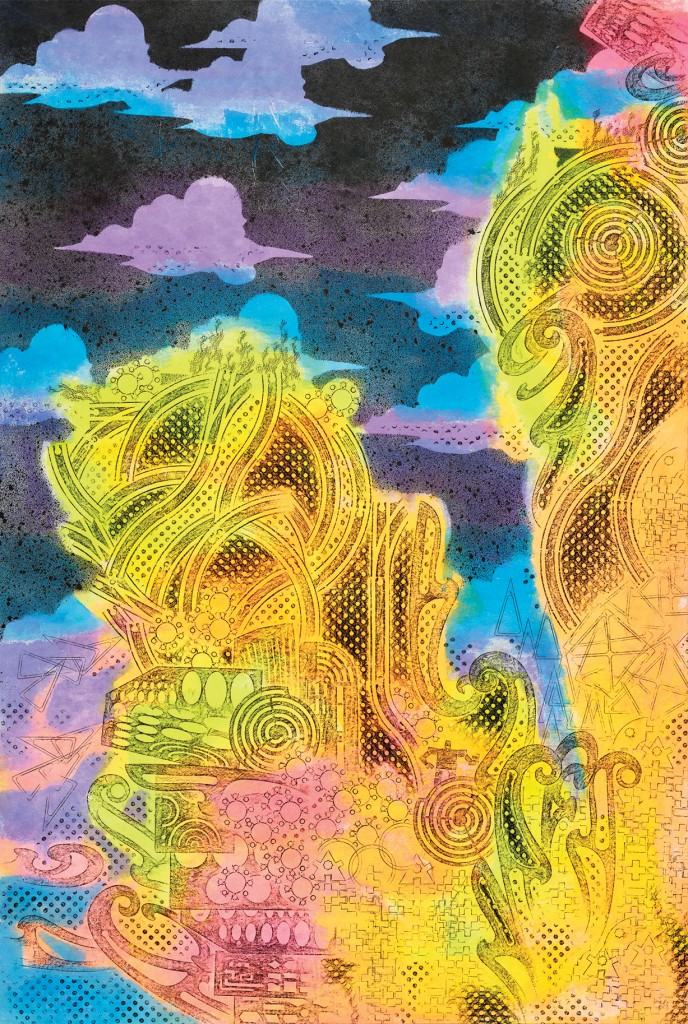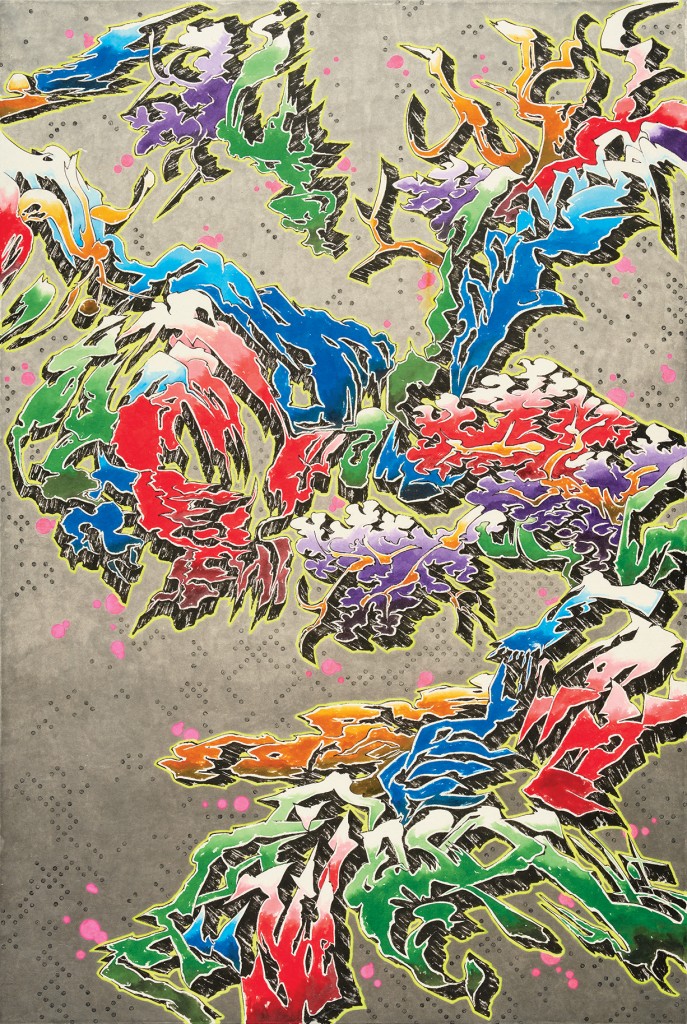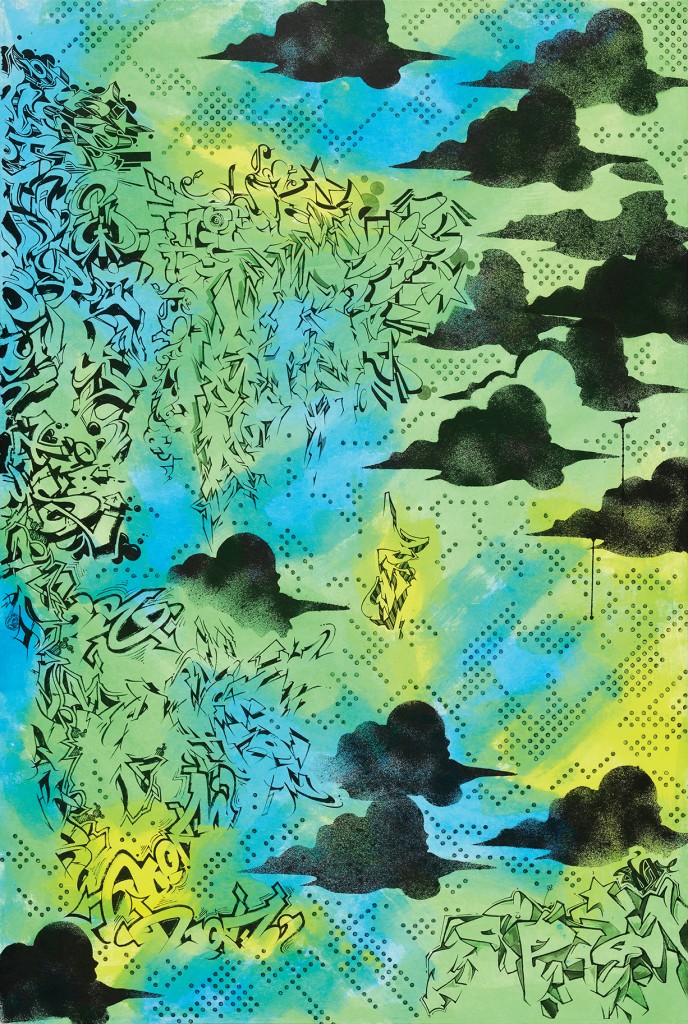Exhibitions

PERIGEE ARTIST #24 손동현
이른 봄
2021.03.04. THU ~
2021.05.08. SAT
<그야말로 이른 봄>
신승오 (페리지갤러리 디렉터)
손동현은 지금까지 그가 즐겨보고 경험하였던 대중문화에서 소재를 찾고, 이를 동아시아의 수묵 방식과 접목하여 다양한 인물화 작업을 선보여 왔다. 이는 슈퍼맨, 배트맨과 같은 영웅에서부터 007시리즈에 등장하는 <악당>연작, 대중문화 스타인 마이클 잭슨을 그린 <왕의 초상>연작에 이르기까지 다양한 캐릭터들을 소재로 하였다. 그는 이뿐만 아니라 다양한 브랜드들의 로고를 문자도로 재해석하거나 영화에 등장하는 뉴욕을 병풍으로 만든<island>, 우주선을 <HyperSpace>연작으로 부채에 그려내기도 했다. 그가 다루는 소재는 대부분 인간의 상상으로 만들어진 실재하지 않는 가상의 존재이거나 어떤 특별한 의미들을 획득한 대중문화의 상징을 표상하는 것들이었다. 2014년 이후에는 여기서 한발짝 더 나아가 자신이 창조해 낸 새로운 영웅들의 인물화를 그려내기 시작한다. 이는 사혁의 화론인 <육법(六法)>을 비롯하여 부벽준, 피마준, 하엽준 등의 준법과 배채법(背彩法), 탁본과 같은 기법 그리고 그래피티와 만화의 형식 등을 사용하여 다양한 의미를 인물화의 틀 안에서 재해석하는 작업이었다. 그럼에도 그의 작업 중에서 본격적인 산수화를 그린 적은 없었다. 그렇기에 이번 전시에서 선보이는 10폭으로 이루어진 <이른 봄> 산수화는 그의 작업 세계를 새롭게 인식할 수 있는....
An early spring indeed
Seung Oh Shin (Director of Perigee Gallery)
Donghyun Son has explored the subject matter of his works in mass culture he enjoyed and experienced, and presented a variety of figure paintings employing techniques from East Asian ink-wash painting. Diverse characters from mass culture are adopted in his works including the Villain series featuring heroes like Superman, Batman, and villains from the James Bond 007 series and the Portrait of the King series portraying Michael Jackson, one of the most prominent mass cultural figures. In addition to this, he has constantly interpreted logos of many brands in Munjado (文字圖, Chinese character painting). His Island is a newly interpreted rendition of the scenes of New York portrayed in films on folding screens and the HyperSpace series is a depiction of spaceships on fans. The motifs he has frequently addressed are mostly nonexistent imaginatively created beings or symbols of mass culture with some specific meaning. After 2014, Son went further and began painting portraits of new heroes he had created. This was work reinterpreting various meanings....
신승오 (페리지갤러리 디렉터)
손동현은 지금까지 그가 즐겨보고 경험하였던 대중문화에서 소재를 찾고, 이를 동아시아의 수묵 방식과 접목하여 다양한 인물화 작업을 선보여 왔다. 이는 슈퍼맨, 배트맨과 같은 영웅에서부터 007시리즈에 등장하는 <악당>연작, 대중문화 스타인 마이클 잭슨을 그린 <왕의 초상>연작에 이르기까지 다양한 캐릭터들을 소재로 하였다. 그는 이뿐만 아니라 다양한 브랜드들의 로고를 문자도로 재해석하거나 영화에 등장하는 뉴욕을 병풍으로 만든<island>, 우주선을 <HyperSpace>연작으로 부채에 그려내기도 했다. 그가 다루는 소재는 대부분 인간의 상상으로 만들어진 실재하지 않는 가상의 존재이거나 어떤 특별한 의미들을 획득한 대중문화의 상징을 표상하는 것들이었다. 2014년 이후에는 여기서 한발짝 더 나아가 자신이 창조해 낸 새로운 영웅들의 인물화를 그려내기 시작한다. 이는 사혁의 화론인 <육법(六法)>을 비롯하여 부벽준, 피마준, 하엽준 등의 준법과 배채법(背彩法), 탁본과 같은 기법 그리고 그래피티와 만화의 형식 등을 사용하여 다양한 의미를 인물화의 틀 안에서 재해석하는 작업이었다. 그럼에도 그의 작업 중에서 본격적인 산수화를 그린 적은 없었다. 그렇기에 이번 전시에서 선보이는 10폭으로 이루어진 <이른 봄> 산수화는 그의 작업 세계를 새롭게 인식할 수 있는 기회가 될 것이다.
손동현의 이번 전시와 작품의 제목인 《이른 봄》은 곽희의 <조춘도(早春圖)>를 부분으로 나누어 구획하여 자신만의 방식으로 그려낸 산수화이다. 곽희의 <조춘도>는 우리가 알고있는 산수화의 기본이 되는 고원(高遠), 심원(深遠), 평원(平遠)의 구도를 모범적으로 보여준다. 그리고 이는 서양과 다르게 하나의 시점을 중심으로 전개되는 것이 아니라 다 시점으로 공간을 분할해서 동아시아 회화 안에서의 전형적인 공간미를 드러내고 있다. 그렇기에 이 곽희의 그림은 작가에게 있어서 자신만의 시선으로 다시 분할하여 새로운 공간감을 드러내는 풍경으로 만들기에 좋은 모티브가 되었다. 한편으로 전통적 산수화의 공간 구성은 그 안을 걷는 듯한 감각을 드러내기 위한 방법으로 이는 집에 누워서 경치를 그 공간을 눈으로 더듬으며 감각해 내는 와유사상(臥遊思想)과 이어진다. 이렇듯 동아시아 수묵화에서의 산수화는 실제 풍경을 사실적으로 묘사하기 보다는 관념적인 공간에 가깝다. 하지만 작가가 관심을 가지는 것은 관념적인 것을 추구하여 마음을 수련하는 어떤 경지에 다다르는 것에 있지 않다. 다만 어떤 법칙에 얽매이지 않고 이것과 저것, 여기와 저기와 같은 서로 다른 것들을 연결시키려는 태도를 견지하는 것에 있다. 따라서 <이른 봄>은 곽희의 그림을 일정 부분을 잘라내어 그린 것이지만 명확하게 어떤 부분을 그렸는지 잘 드러나지 않고 일부러 그것을 찾아낼 필요도 없다. 또한 이번 글도 개별 작품을 분석하기 보다는 전반적인 작업 과정과 흐름에 대해 살펴볼 것이다.
먼저 작품 제목인 <이른 봄>은 <조춘도>의 의미를 우리 말로 옮긴 것 외에 작가는 사실상 과거의 명화를 재해석하는 것에 목적을 두고 있지 않다. 그는 <조춘도>를 자신이 그리고자 하는 산수의 기본 형태를 제공받기 위한 재료로 선택하였다. 그럼에도 작품과 전시제목으로 《이른 봄》을 사용한 것은 어떤 의미를 가지는가? 이는 무엇인가가 완벽하게 정점에 다다른 것이 아닌 이제 시작점에서 조금 지났을 뿐인 미성숙의 시공간이다. 하지만 이른 봄에 돋아나는 새싹이나 아직 잎이 나기 전에 꽃을 피우는 매화는 생명의 기운이 응축되어 조만간 충만하게 되리라는 것을 감지하게 만든다. 이와 같이 작가의 신작은 무엇인가가 원숙한 것을 드러내기보다는 미성숙의 단계에서 나타나는 기운으로 가득 찬 보이지 않는 감각들을 담아내고자 한다. 그리고 이를 획득하기 위해서는 작업 안에서의 재료와 기법에 대한 유연함이 필요하며, 그리는 것에 대해 얼마나 자유로움을 가지고 있는지에 따라 좌우된다고 본다. 이처럼 이번 신작에서의 변화 중 하나는 처음에는 인물화를 그리듯이 본을 그리고 명확한 계획에 의해 시작되었지만 작업이 진행되어 나가면서 점차 즉흥적인 화면 구성과 표현을 보여주는 데에 있다. 물론 그는 그림에서의 자유 분방함도 최소한의 형식과 재료가 가진 기본 틀 없이 나올 수 없다는 것을 알고 있으며, 따라서 산수화라는 형식과 더불어 재료의 성질과 도구의 숙련도에 대한 중요성을 무시하지 않는다. 이렇게 완성된 그의 <이른 봄>은 전통적인 산수에 일반적으로 사용하는 준법들을 거의 사용하지 않고 분무, 탁본, 배채법, 다양한 잉크, 그래피티, 만화 등 서로 다른 재료와 기법들로 조합된 모습을 보여준다. 처음에도 언급한 것처럼 그의 인물화는 전통의 기법과 현재적 소재의 결합이었다. 그러나 그 이후 자신이 창조해낸 영웅들을 한자(漢字)와 같은 표의문자와 그 대상이 의미하는 이미지를 연결시키고, 이를 동아시아 수묵화의 기법과 재료를 기본으로 하여 표현하였다. 여기서 더 나아가 <이른 봄>에서는 단순하게 전통적 재료와 현대적 소재, 혹은 만화와 같은 대중문화와 순수 미술이라는 명확한 경계를 가진 것들의 조합보다는 이러한 요소들이 더욱 뒤섞여 혼재된 풍경으로 만든다. 그리고 자신이 적합하다고 생각하는 여러 방법을 취하여 최대한 유연하게 사용하기 위해 노력하고 있다. 그렇기에 그의 산수는 어느 하나의 고정된 형식으로 이루어진 것이 없이 다양하며, 자신이 지금까지 해오던 방식에서 벗어나면서도 자신만의 표현법을 자연스럽게 구축해 나가고 있다. 따라서 이번 신작인 <이른 봄>은 지금까지 그의 작업을 이미 알고있거나 많이 접한 사람들에게는 인물이 등장하지 않는 것을 제외하고는 그리 낯선 것으로 보이지 않는다. 이는 각 장면마다 그가 지금까지 다른 방식을 사용하면서도 이전과 그리 다르지 않은 감각들을 화면에 자연스럽게 녹여내기 때문이다. 그러므로 이전까지와 다르게 이번 산수화로 그가 드러내는 것은 자신이 지금까지 해온 회화의 길에서 얻어진 모든 것을 체화(體化)하고, 이를 다시 새로운 화면 안에 자유자재로 담아내는 회화적 행위이다.
그렇다면 그는 왜 이러한 작업적 태도를 보이는가? 그의 초기의 인물화 작업은 우리 주변의 경험을 바탕으로 그 대상의 내부에 진입하기 위한 것 보다는 대상의 표면을 관찰하는 것을 기반으로 한다. 하지만 그 이후에는 자신만의 영웅들을 그려내면서 기운생동(氣韻生動)과 같은 비가시적인 흐름과 의미에 대한 관심으로 점차 이동하였다. 이렇게 구체적인 형태가 없는 어떤 대상을 명료하고 객관적으로 인식하는 것은 어려운 일이다. 그렇기에 그가 자주 소재로 삼는 텍스트와 이미지의 연결은 처음에는 명확한 의미를 형상화 하였지만 이후의 작업에서는 이러한 각자가 드러내는 의미와 표면을 겹겹으로 쌓아 연결시켜 오히려 그 경계가 모호한 상태로 그려내기도 하였다. 이번 산수화에서는 이러한 점이 한층 진전되어 그 이미지와 텍스트의 내면의 의미들이 충돌하여 분산되듯이, 그림에서 다양한 기법들로 표면의 흐름을 강조하여 산수의 형태를 잡아가며 그려내는 것이다. 이는 어떤 특정한 대상에 집중하는 것이 아니라 작가가 살아가면서 관심을 두는 많은 것들에서 자연스럽게 얻어지는 감각들에 의존한다. 이렇듯 여러 방식으로 그려지는 나무와 산, 하늘, 길, 구름, 건물, 텍스트 등 산수 안에서 파편적으로 보이는 대상들의 조합과 형태 그리고 흐름은 지속적인 작업과정을 통해 얻어진 자연스러운 체화의 결과이기도 하다. <이른 봄>에서는 자신의 시각적 경험을 포함한 다양한 감각들이 화면 안에서 상호작용 하며 유동적인 움직임을 보이고 있다. 하지만 우리도 알다시피 우리가 살아가고 있는 현재라는 시공간이 어떻게 자신에게 다가오는지 정확하게 표현해내기 힘들다. 다만 추상적인 형태로 머리 속을 떠돌 뿐이다. 그렇기에 작가는 이를 저 멀리 있는 아련한 풍경이 아니라 확대되고 밀착된 동적인 흐름으로 가득한 공간으로 그려낸다. 이는 과거의 관념적인 산수화도 아니고 실제를 담은 것도 아닌 지금 현재 우리가 살아가고 있는 시공간을 다양하게 인지하면서 축적된 감각적인 풍경이다. 물론 이를 형상화하는 방식은 전통적인 재료와 기법을 사용하지만 거기에 머무는 것이 아니라 새로운 재료를 쉽게 받아들이고, 분무를 하거나 탁본으로 찍어내고, 선 붓을 사용하지 않는 것처럼 자신에게 가장 익숙한 도구 이상의 무엇을 항상 모색한다. 왜냐하면 이러한 방식이 자신이 마주하는 과거와 현재가 혼재하고, 가상과 실제의 경계가 모호하고, 현실이 비현실로 전환되는 그 복잡하고 미묘한 지점들을 담아내는 데에 적합한 방식이기 때문이다. 따라서 그의 <이른 봄>은 구체적인 형상을 가지고 있지만 추상적인 풍경이다. 사실 우리는 지금까지 그의 작업이 어떤 답을 찾고 있고 그 결과를 보여주는 것이라 생각해 왔다. 하지만 그의 작업은 어쩌면 계속해서 자기 스스로에게 던지는 질문으로 보인다. 이는 다른 사람에 의해 인정되기 보다는 자신이 그린 그림에 자신이 만족하기 위한 득의작(得意作)을 만들기 위한 태도에 가깝다. 그렇기에 이번에 선보이는 산수는 자신이 좋아하고 익숙한 소재와 방법을 통해 가시적인 것과 비가시적인 것처럼 상충되는 것들 사이를 어떻게 연결하고 재조합하여 형상화할 것인가에 대해 마치 혼자만의 게임을 즐기는 것과 같다.
결론적으로 《이른 봄》을 통해 우리는 손동현의 작업을 어떻게 읽어내고 있는가에 대해 다시 생각해볼 필요가 있다. 우리는 동아시아 수묵화의 화론이나 기법에 대해 얼마나 익숙할까? 우리는 이미 많은 전통적인 감각을 결여하고 있다. 그렇기에 대부분 그가 사용하는 기법과 언급되는 화론, 그린 대상의 상징적 의미에 대한 설명이 필요하다. 물론 이는 그의 작업을 이해하기 위한 정보이지만, 한편으로는 작품 그 자체의 표면으로 보여지는 것을 감각적으로 이해하는 데에는 장애가 되기도 한다. 그렇다면 우리가 살아가는 현재적 풍경은 어떻게 설명되고 그려질 수 있을까? 그것은 구체적인 형상에 대한 서술로 이어질 수도 있지만, 추상적인 형태로 다가오기도 한다. 그리고 이것은 구체적인 언어로 설명하기 불가능한 것 결국 어떤 이미지로 대체되지만 언제나 명확하게 정의할 수 없는 것이다. 작가는 이렇게 서로 다른 시간과 공간, 추상과 형상 사이의 유격을 최대한 밀착시키고자 한다. 그렇기에 그가 보여주는 <이른 봄>은 단일한 시공간의 단단한 지평이 아니라 여러 시공간의 일시적 결합으로 나타나는 유동적인 공간이다. 이것은 지식을 통해 획득될 수 있는 이해의 단계가 아니라 지금 현재를 살아가는 사람들이 자연스럽게 스며들어 체득하게 되는 감각으로 지각 되어야 한다. 또한 그는 이번 작품에서 소재, 재료, 기법, 과거와 현재, 가상과 현실을 동등한 층위에 놓고 그 어느 때보다 자유롭고 느슨하게 작업하고 있다. 여기에 더해 자신이 할 수 있는 가장 기본적인 욕망에 충실하고, 자신의 취향을 숨기지 않고 드러낸다. 그렇다면 작가가 할 수 있는 한 최대한 다양한 표현법을 보여준 이전까지의 전시들은 관객들이 자신의 작업을 쉽게 읽어낼 수 있는 감각적 코드를 만들어 내는 과정이 아니었을까? 이러한 과거의 여정이 있었기에 손동현이 지금까지 만들어온 여러 코드는 우리에게 결여된 것을 채우고, 아직은 도래하지 않은 것을 드러내어 그의 작품을 자연스럽고 익숙한 것으로 다가오게 만든다. 따라서 우리는 그의 이번 작업을 특정한 정보를 통해 이해하기보다 화면에서 펼쳐지는 색, 선, 형태, 흐름을 좀 더 직관적으로 바라볼 때 그의 산수를 충만하게 느끼게 될 것이다. 이렇게 이번 전시는 그의 작업을 다시 보기 위한 출발점, 말 그대로 이른 봄이다.
Seung Oh Shin (Director of Perigee Gallery)
Donghyun Son has explored the subject matter of his works in mass culture he enjoyed and experienced, and presented a variety of figure paintings employing techniques from East Asian ink-wash painting. Diverse characters from mass culture are adopted in his works including the Villain series featuring heroes like Superman, Batman, and villains from the James Bond 007 series and the Portrait of the King series portraying Michael Jackson, one of the most prominent mass cultural figures. In addition to this, he has constantly interpreted logos of many brands in Munjado (文字圖, Chinese character painting). His Island is a newly interpreted rendition of the scenes of New York portrayed in films on folding screens and the HyperSpace series is a depiction of spaceships on fans. The motifs he has frequently addressed are mostly nonexistent imaginatively created beings or symbols of mass culture with some specific meaning. After 2014, Son went further and began painting portraits of new heroes he had created. This was work reinterpreting various meanings in figure painting through the Six Principles of Chinese Painting asserted by Xie He. He makes use of traditional Korean brush techniques like brush strokes made as if they were cut with an ax, brush strokes that move down to create the effect of a loose hemp fiber, brush strokes that resemble the stems of a lotus leaf, the coloring technique of brushing on the backside of paper or cloth, rubbing techniques, and forms of graffiti and cartoon. He has never painted landscapes in earnest in his career. Thus, the eight-fold folding screen landscape painting titled Early Spring on display at this exhibition will serve as an opportunity to newly realize his art world.
Early Spring, the title of both this exhibition and his artwork is a landscape painting that dismantles Guo Xi’s Early Spring and recreates it in his own distinctive way. Guo Xi’s Early Spring demonstrates his innovative techniques for producing multiple perspectives that are called high distant (高遠), deep distance (深遠), and level distance (平遠), the basics of landscape painting. This painting displays the beauty of space typical to East Asian paintings through a partition of space with multiple perspectives unlike the single perspective normally adopted in Western paintings. This painting by Guo Xi has been a superb motif for Son to generate a new sense of space by dividing it using his own point of view. In a sense, the space composition of a traditional landscape painting is also bound up with the idea of woyou (臥遊, aimlessly wandering while lying down) that means sensing a landscape or a space when appreciating while lying down at home. Like this, East Asian ink-wash landscape paintings are not a depiction of a real landscape but are more a notion of space. All the same, what Son is interested in is not to reach some state of cultivating and disciplining his mind while seeking something abstract but to associate mutually different things with each other untrammeled by any law. Accordingly, Son’s Early Spring roughly depicts some part of Guo Xi’s Early Spring, but it does not clearly show which part it captures and there is no need to intentionally find this out. This article will also give an overview of his process and flow instead of analyzing each piece.
Son’s Early Spring actually does not aim to reinterpret a masterpiece from the bygone days. He has chosen Guo Xi’s Early Spring as the source of the elemental form of his landscapes. Even so, what does his use of the title Early Spring both for his artwork and exhibition mean? Early spring refers not to something being completely at its zenith but to an immature space-time almost close to a starting point. And yet, condensed in plum blossoms blooming before sprouts or leaves appear, this point of time has us sense that it will soon be replete with the vitality of life. That being so, Son’s new work tries to encapsulate invisible senses filled with vitality that emerges at an immature stage. And, flexibility in choosing materials and techniques is required to attain this and it is determined by how free he is in his expression. One of the most significant changes in his new work is that he initially drew sketches as if doing figure paintings and had to depend on a plan but gradually showed improvisatory composition and representation as his work progressed. Of course, he is well aware that any freewheeling style in painting cannot be brought about without the fundamental frame of form and material. Thus, he would not disregard the importance of properties of materials and skills in using tools as well as styles in landscapes. His Early Spring completed in this way interestingly demonstrates a combination of different materials and techniques such as spraying, rubbing, back painting, diverse inks, graffiti, and cartoon rarely using brush techniques generally intrinsic to traditional landscapes.
As mentioned above, his figure paintings were particularly marked by the integration of traditional techniques into modern subject matter. After that, however, he related the heroes he had created to ideograms like Chinese characters and their signifying images and represented them based on East Asian ink-wash painting techniques and materials. His Early Spring is not simply the fusion of elements with clarified boundaries like traditional materials and modern subject matter as well as mass culture like cartoon and fine art, but an especially distinctive melding of these elements. He is trying to diversely take many ways he considers appropriative and use them as flexibly as he can. Thus, his landscapes vary in form, naturally forging his own pictorial idioms while departing from the styles and methods he has so far pursued. For this reason, his new work Early Spring seems not so strange to those who know his work, save for some figure in this painting. This is because he naturally melds into the sensation not so different from his previous pieces while employing ways that are different from those he has thus far chosen. Thus, what he unmasks in this landscape is a pictorial action to strenuously embody and internalize everything he has gained on the path of painting and to quite freely express them in his new work.
If so, why does he show this attitude? His early figure paintings were anchored in observing the surface of an object rather than penetrating into its interior based on his experience with the surroundings. From then on, however, he gradually moved to his interest in an invisible stream and meaning like spirit resonance or vitality, constantly portraying his own heroes. It is really difficult to perceive some invisibly formless objects obviously and objectively. Thus, he initially tried to clearly make a link between text and image, but after that time intended to represent a blurred boundary between them by staking each meaning and surface in layers. As this aspect is advanced in this landscape, its images collide with inner meanings in its text and are dispersed. In this way, he brings form to a landscape, emphatically stressing the flow on the surface in a variety of techniques. This work rests heavily on the senses naturally gained from things he has paid attention to in his life, instead of focusing primarily on any specific object. The combination, form, and flow of seemingly fragmentary objects in his landscapes, such as trees, mountains, the sky, paths, clouds, buildings, and text are the result of embodiment and internalization he has naturally gained through his constant working process. Different senses including his visual experience interact with one another in his work, displaying a fluid movement. As we know, however, it is hard to accurately represent how space-time of the present comes close to us. This keeps just abstractly going round in our heads. Therefore, he represents this as a space filled with close, expanded dynamic streams, not a far-way dim landscape. Son’s work is a sensuous landscape in which he diversely perceives and amasses the space-time we currently inhabit. Of course, he uses traditional materials and techniques to represent this but goes further, not staying there. He has consistently explored something innovative, such as embracing new materials, spraying, rubbing, and using tools most unfamiliar to him. That’s why this is a suitable way to capture some intricate, subtle point where the past he faced is mixed with the present, the boundary between imagination and reality becomes blurred, and reality is converted into unreality. Accordingly, his Early Spring captures some concrete image but is abstract. We have always thought his wok is to search for some answer and show the result. His work seems to be a question he probably constantly asks himself. This approximates an attitude to produce a masterpiece with which he himself is satisfied, rather than being appreciated by others. Therefore, the landscape on show at this exhibition is like enjoying a game alone, as to how to relate, remerge, and represent conflicting things such as the visible and invisible through subject matter and method he prefers and feels familiar.
To conclude, we need to reconsider how we are interpreting Son’s work through his Early Spring. How familiar to East Asian ink-wash painting theory and technique are we? We may already lack traditional senses. Therefore, accounts of the technique he employs, the theory critics mention, and the symbolic meaning of the objects he portrays are required. These are of course snippets of information needed to grasp his work but in a sense they at times become an obstacle to understand what is superficially showcased. How can the landscape in which we presently inhabit be explained and depicted? This can be a description of any concrete form but sometimes appears abstract. And, this is inexplicable and cannot be defined while it is replaced with some image. In this way, the artist tries to bring different spaces and times as well as figuration and abstraction together as closely as possible. Thus, his Early Spring shows a fluid space engendered by temporarily joining different spaces and times, not one single space and time. This has to be perceived by the senses of those who live presently, not at the stage where they understand it with their knowledge. He more freely and loosely works for this piece than in any other paintings, placing subject matter, material, technique, the past and present, imagination, and reality on the same layer. In addition to this, he is faithful to the most basic desire he can pursue, unmasking his preference. If so, were his previous exhibitions in which he showcased various expressive methods perhaps the process of creating sensuous codes with which viewers can read his work? A variety of codes he has made can have us naturally feel his work is familiar by resolving deficiency and revealing the not yet arrived because he made this journey in the past. As a result, we may be able to feel his landscapes as something replete when intuitively seeing colors, lines, images, and flows in his paintings rather than grasping his work through any specific information. Consequently, this exhibition is a starting point for looking at his work anew, an early spring indeed.



